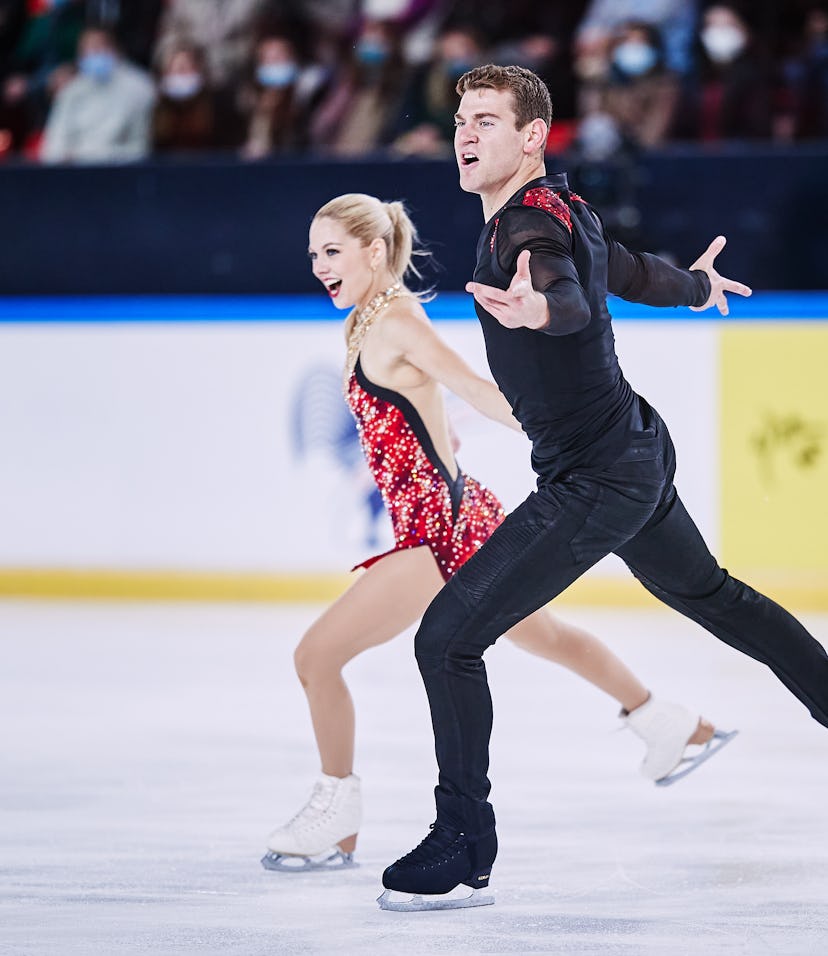
Here Are The Key Differences Between Ice Dancing And Pairs Figure Skating
Jumps are a big giveaway.
Figure skating is arguably one of the most enigmatic and difficult sports to follow in the Winter Olympics. To make it more complicated, there are actually two different types of coupled skating events: figure skating and ice dance. Unless you know the difference between ice dancing and pairs figure skating, it might look like it’s all a bunch of fancy spins on ice. When it comes to ice dance versus pairs figure skating, here’s how to spot the differences between the two, so you can watch the 2022 Winter Olympics like a pro.
With the costumes, the music, and the mind-blowing moves, figure skating gives you a lot to keep track of. For the 2022 Winter Olympics, two teams of pairs figure skaters and three ice dance pairs will represent Team USA in Beijing. Pairs skaters Alexa Knierim and Brandon Frazier actually had a bit of a journey to the games, given that the 2022 Winter Olympics are taking place during a worldwide pandemic. They had to sit out the figure skating nationals in early January 2022 due to Frazier’s positive COVID diagnosis at the time, per NBC Sports, but the pair was able to petition to compete in the Olympics and they were announced as part of Team USA for the 2022 Winter Olympics on Jan. 9. Knierim and Frazier and ice dancers Madison Hubbell and Zachary Donohue will compete on Friday, Feb. 4, as part of the team event.
Both events (ice dance and pairs figure skating) feature two skilled skaters competing together on ice, and they can look almost identical if you don’t pay attention. There are two stages, called programs, in both sports. The short program is generally more technical and requires competitors to perform selected moves. The long program, also called the free program, gives competitors more flexibility to showcase their strengths with a longer routine.
Ice dancing and pairs figure skating both have skating and dancing elements, so the differences lie in the details.
Pairs Figure Skating
Unison is key in pairs. In a short program, pairs skaters are required to complete “lifts, side-by-side solo jumps done in unison, throw jumps, a step sequence, and a death spiral,” per the U.S. Figure Skating website. (Worth noting: Ice dance doesn’t allow jumps.) Pairs skaters will implement shadow skating (identical maneuvers performed with distance between them) and mirror skating (moves done in opposite directions to mirror each other) to highlight their strength as a team. Free skate focuses more on technical skill and choreography, again illustrating how they work together.
You used to be able to tell right away that it wasn’t pairs skating if there were lyrics, but 2018 marked the first Winter Olympics where the controversial rule change to allow music with lyrics took effect, so that test is gone.
The time limit for short program pairs skating is just under 3 minutes, and for the free skate, the programs are just over 4 minutes, for a total of about 7 minutes on the ice, per the official Olympics website.
Ice Dance
Ice dance has roots in ballroom dancing. The ice dancers’ programs focus more on the rhythm of the music and creating moves that embody it. Judges are watching for more traditional dance elements like synchronicity, musical interpretation, precise footwork, grace, elegance, and overall artistry. In addition, partners are scored on their skating speed and angle, which should be in perfect sync.
In ice dance, the short program runs between 2 minutes and 50 seconds and 3 minutes, and the long program lasts between 3 minutes and 50 seconds to 4 minutes and 10 seconds. Ice dancers have always been allowed to skate to lyrical songs.
There’s a rhythm dance and a free dance. Rhythm dance requires “lifts, step sequences and pre-determined dance patterns performed to a specific rhythm of music within a required tempo range,” per the U.S. Figure Skating website.
Per U.S Figure Skating, ice dancers’ goal for the free dance is to pull off “an entertaining, moving, and inspiring performance that looks effortless despite its difficulty.” To do that, they must perfect choreography, timing, and rhythm.
An easy distinction for the folks at home: If the music is more melodic, and if the routine involves lots of jumps, throws, and spins, it's probably figure skating. If the music is rhythmic, and the skaters are more focused on technical footwork (keeping their skates on the ice) and styling, it's probably ice dancing.
Both events promise to provide quite impressive routines, so tune in and spot the differences in these highly anticipated Winter Olympics events.
This article was originally published on